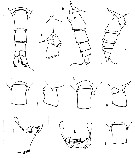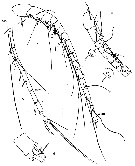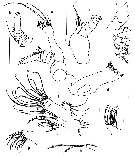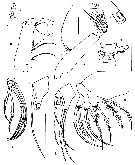|
|
 |
Fiche d'espèce de Copépode |
|
|
Calanoida ( Ordre ) |
|
|
|
Clausocalanoidea ( Superfamille ) |
|
|
|
Aetideidae ( Famille ) |
|
|
|
Pseudeuchaeta ( Genre ) |
|
|
| |
Pseudeuchaeta vulgaris Markhaseva, Mohrbeck & Renz, 2017 (F) | |
| | | | | | | Ref.: | | | Markhaseva & al., 2017 (p.291, Descr. F, figs.F, Rem.) |  Issued from : E.L. Markhaseva, I. Mohrbeck & J. Renz in Mar. Biodv., 2017, 47. [p.290, Fig.1]. Female (from 11°49.8'N, 117°00.4W): a-b, habitus (dorsal and lateral, respectively); c, cephalosome (dorsal anterior); d-e, rostrum (lateral view); f, rostrum (ventral view); g, caudal rami ( (dorsal). Scale bars: 1.0 mm (a-e); 0.5 mm (f-g). Nota: - Rostrum as rounded plate. - Cephalosome and 1st pedigerous somite incpmpletely fused, 4th and 5th pedigerous somires incompletely fused. - Posterior corners pointed directed dorsally, slightly diverging or not. Urosome 4-segmented. - Genital double-somite symmetrical. - Caudal rami slightly longer than wide; 1lateral seta (II), 1 ventral seta (VII), and 4 terminal setae (III-VI).
|
 Issued from : E.L. Markhaseva, I. Mohrbeck & J. Renz in Mar. Biodv., 2017, 47. [p.291, Fig.2]. Female: a, urosome (dorsal); b-c, same (left and right lateral); d, f, h, posterior prosome and genital double-somite (lateral); e, g, i, posterior prosome and genital double-somite (dorsal); j, k, genital field in lateroventral and ventral view; Scale bars: 1.0 mm (a-i; 0.5 mm (j-k). Nota: Spermathecae directed dorsoanteriorly and at varying angles
|
 Issued from : E.L. Markhaseva, I. Mohrbeck & J. Renz in Mar. Biodv., 2017, 47. [p.292, Fig.3]. Female: a, A1 ancestral segments I-XI, arroxs mark small sensilla; b, A1, ancetral segments I-XVIII; c, A1, ancestral segments XIX- XXVIII; d, A1, ancestrak segments XXVII-XXVIII. Scale bars: 1.0 mm (a-c); 0.1 mm (d). Nota: A1 24-segmented, . longer than prosome, reaching (usually) posterior part of genital double-somite. In some specimens small sensilla are visible on antennule proximal segments I-XI (marked by arrows).
|
 Issued from : E.L. Markhaseva, I. Mohrbeck & J. Renz in Mar. Biodv., 2017, 47. [p.293, Fig.4]. Female: a, A2; b, A2 exopod; c, Md palp; d, Md gnathobase; e, Md cutting edge; f, Mx1 (setae of proximal basal endite not figured); g-i, Mx1 praecoxal arthrite; h, Mx1proximal basal endite. Scale bars: 0-.5 mm (a-d, f-i); 0.1 mm (e). - A2: coxa with 1 seta, basis with 1 seta, exopod incompletely 9 segmented (2nd and 3rd proximal segments partly separate) with 1-1, 1, 1, 1, 1, 1, 1, 0, and 3 setae; 1st endopodal segment without setae, 2nd with 8+6 setae. - Md: gnathobase cutting edge with 6 teeth, seta and needle-like spinules; basis with 1 seta; exopod 5-segmented with 1, 1, 1, 1, and 2 setae; endopod segment 1 with 1 seta, segment 2 with 5 setae (4 long and 1 additional very short and reduced un some specimens). - Mx1: praecoxal arthrite with 9 terminal and 3 posterior setae with tiny spinules at bases of inner terminal setaz; coxal endite with 4 setae; proximal basal endite with 2 setae, distal basal endite with 4 setae (in one specimen of additional material, left limb with deviating setation of 5-6 setae); endopod with 15-16 setae; exopod with 11 setae; coxal epipodite with 7 long and 1 short setae (in one specimen of additional material, left limb with deviating setation of 9 setae), its common maxillule setation formula: 9+3, 4, 2, 4, 15-16, 11, 8.
|
 Issued from : E.L. Markhaseva, I. Mohrbeck & J. Renz in Mar. Biodv., 2017, 47. [p.294, Fig.5]. Female: a, Mx2 (praecoxal, coxal and basal endites); b, Mx2 (endite-like lobe of proximal endopodal segment and endopod; c, Mx2 (endite-like lobe of proximal endopodal segment and proximal segment of endopod; d, Mx2 (3 distal endopod segments); e, Mxp (syncoxa and proximal part of basis); f, Mxp (sensory appendage of coxa); g, Mxp (basis and endopod 'Enp'); h, Mxp (basis distal part, endopod segments 1 and 2, only 2 thick setae of endopod segment 2 figured). Scale bars : 0.5 mm. Nota; - Mx2: all endites and proximal endopodal segment enditic-like lobe with 3 setae; endopod with 6 setae. - Mxp: praecoxal endites of syncoxa with 1, 2 and 3 setae (from proximal to distal), coxal endite with 3 setae and elongated sensory attenuation; basis with 3 medial setae; endopod 6-segmented with 2, 4, 4, 3, 3+1, and 4 setae (2 setae on each of endopod 2 to 6 segments are significantly smaller and thinner); long detae of endopod segments 2-6 supplied by crescent-like structures typvcal of the genus.
|
 Issued from : E.L. Markhaseva, I. Mohrbeck & J. Renz in Mar. Biodv., 2017, 47. [p.295, Fig.6]. Female: a, P1; b, P2; c, P3; d, P4. Scale bars: 0.5 mm.
| | | | | NZ: | 1 | | |
|
Carte de distribution de Pseudeuchaeta vulgaris par zones géographiques
|
| | | | Loc: | | | N Pacif. (off NW Clipperton Islands
Type locality: 13°49.9' N, 116°34.5' W | | | | N: | 1 | | | | Lg.: | | | (1213) F: 7,00-7,60; {F: 7,00-7,60} | | | | Rem.: | Abyssal (about 4000-4400 m) samples close to the seabed.
For Markhaseva & al. (2017, p.293) the differential diagnosis of this species from its congeners is: 1- Posterior corners are pointed, directed dorsally and more or less diverging; 2- A1 reaches the middle length of posterior border of genital double-somite; 3- Md endopodal segment 2 with 5 (rarely 4) setae: 4- Mx1 coxal endite with 4 setae; proximal basal endite with 2 setae; distal basal endite with 4 setae; 5- Sensory appendage on coxal endite of Mxp syncoxa shorter than the two distal setae; 6- P1 exopodal segment 1 without lateral spine.
The species name ''vulgaris'' refers to the morphology of the species, which is typical for the genus Pseudeuchaeta. | | | Dernière mise à jour : 19/06/2023 | |
|
|
 Toute utilisation de ce site pour une publication sera mentionnée avec la référence suivante : Toute utilisation de ce site pour une publication sera mentionnée avec la référence suivante :
Razouls C., Desreumaux N., Kouwenberg J. et de Bovée F., 2005-2025. - Biodiversité des Copépodes planctoniques marins (morphologie, répartition géographique et données biologiques). Sorbonne Université, CNRS. Disponible sur http://copepodes.obs-banyuls.fr [Accédé le 29 décembre 2025] © copyright 2005-2025 Sorbonne Université, CNRS
|
|
 |
 |









